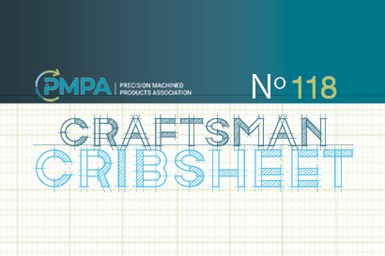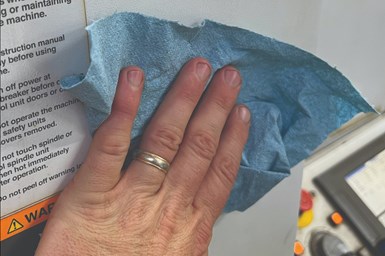Craftsman Cribsheet No. 118: Put A Little Shine In Your Day
A few hours of preventive maintenance time now will save you an order of magnitude in downtime later by getting ahead of problems.

We talk about 5S a lot in manufacturing. There are signs hanging up everywhere. We get emails about it. We go to sessions at conferences that give us all types of systems and tricks. Some of this gets lost in the day-to-day struggle in a shop. We build the system but bypass some of the steps.
If you had a collector’s car, you would wash it and wax it. You would not let it sit in the garage gathering dust. If you took it out and drove it, you would certainly not let it stay grimy and park it. You take care of an expensive collector car. It’s something you spend time checking for oil leaks and the door seals, and ensuring everything is in tip-top shape.
Now I ask you, do you do the same for your machine tools? Most of the tools in our shops cost as much or more than a new Ferrari. When is the last time you washed and waxed your machine tool? You read that right. I just asked when the last time was you did a full detail on your machine tool. That is the third S in 5S right? You are supposed to shine.
If you are not doing detail work on your machine tools, this is why you should. When you walk up to a machine tool that has oil and grime all over it, how do you tell if it is leaking oil or if that was just splashed on there? If there is hydraulic oil all around the way oil reservoir, how do you know if it is leaking? Is the sight glass so cloudy you can’t even see how much oil is in there? If so, there is no way you will be able to see the condition of the oil in the reservoir. How often do you trace down the way lube lines to ensure they are pumping? If the drip points are full of chips and debris, you can’t. The way lube may not even be reaching its intended target.
You should be doing regularly scheduled details on your machine tools. Once a month is a good time frame. You don’t even have to shut the machine down for external work. Just wipe down covers and keypads while it’s in production. Then schedule a few hours of downtime a month to go in and do a deep clean on the parts you can’t reach with it running. A few hours of preventive maintenance time now will save you an order of magnitude in downtime later by getting ahead of problems. Think of this machine like that collector car. Clean all the areas. Make sure to clean your keypads. Keypads that look worn, are usually just grime.
Make sure to clean the fans on all the motors and cabinets — those fans keep your sensitive electronics cool and you don’t want coolant mist clogging them. Check for hydraulic leaks. Check for air leaks. Are there chips building up anywhere they shouldn’t? Check that door interlocks are working correctly. Check seals on doors and spindles. This is the time to really make sure everything is as it should be.
A couple tablespoons of Dawn dishwashing liquid in a spray bottle filled with water works well. For the bulk cleaning — such as chips, debris and heavy oily grime — use a heavy duty wiper, then use a softer disposable shop towel to buff the finish. Also, buff the paint to make your machine shine. Take pride in what you do. Our machine tools are like Ferraris that we use every day.
About the Author
David Wynn
David Wynn, MBA, is the PMPA Technical Services Manager with over 20 years of experience in the areas of manufacturing, quality, ownership, IT and economics. Email: dwynn@pmpa.org — Website: pmpa.org.
Related Content
Machining Unleaded Materials — Reliability is Possible
Leaded steel is no longer produced in the United States. How do shops approach unleaded brass and steel machining?
Read MoreTurned and Polished Steel Barstock: How It Is Manufactured, How It Impacts Your Shop
Understanding the benefits provided by turned and polished steel barstock and its differences from cold-drawn steel barstock can help you and your team avoid unexpected performance issues.
Read More‘Can You Hold This Tolerance?’ Is Not An Engineering Question
The implications of tolerances go far beyond mere technical compliance.
Read MoreOnshoring Weather Report: Strong Tailwinds!
Onshoring, reshoring, nearshoring: these terms are showing up with increasing frequency in the news and online. But is there evidence that these are real?
Read MoreRead Next
5 Aspects of PMTS I Appreciate
The three-day edition of the 2025 Precision Machining Technology Show kicks off at the start of April. I’ll be there, and here are some reasons why.
Read MoreA Tooling Workshop Worth a Visit
Marubeni Citizen-Cincom’s tooling and accessory workshop offers a chance to learn more about ancillary devices that can boost machining efficiency and capability.
Read MoreDo You Have Single Points of Failure?
Plans need to be in place before a catastrophic event occurs.
Read More












.jpg;maxWidth=300;quality=90)










